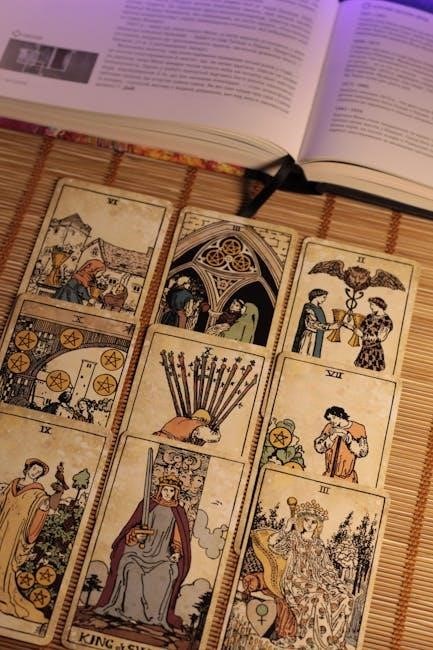Alexander and the Terrible, Horrible, No Good, Very Bad Day is a beloved children’s book that resonates with readers of all ages. Its humorous take on the challenges of childhood, paired with a relatable story, makes it a timeless classic. The book’s appeal lies in its ability to address universal emotions through Alexander’s experiences, offering a lighthearted yet meaningful exploration of dealing with bad days. The availability of the book in PDF format has further expanded its reach, allowing readers to enjoy this heartfelt story conveniently.
Overview of the Book “Alexander and the Terrible, Horrible, No Good, Very Bad Day”
Alexander and the Terrible, Horrible, No Good, Very Bad Day, written by Judith Viorst and illustrated by Ray Cruz, is a humorous yet poignant tale about a young boy’s misadventures. Alexander’s day begins poorly and spirals into a series of comedic mishaps, leading him to contemplate moving to Australia. The book captures the universal experience of dealing with bad days, offering a relatable and lighthearted perspective on childhood struggles. Its timeless appeal has made it a favorite among children and parents alike, while its availability in PDF format ensures easy access for modern readers.
Importance of the Book in Children’s Literature
Alexander and the Terrible, Horrible, No Good, Very Bad Day holds a special place in children’s literature for its candid portrayal of childhood frustrations. The book’s ability to validate negative emotions while maintaining a lighthearted tone makes it a powerful tool for teaching resilience. Its universal themes of coping with setbacks resonate deeply with young readers, helping them understand that bad days are temporary. The story’s accessibility in PDF format has further amplified its reach, ensuring its timeless message continues to inspire children and educators alike, fostering emotional growth and empathy.
Background of the Book
Alexander and the Terrible, Horrible, No Good, Very Bad Day was written by Judith Viorst and first published in 1972. The book’s simple yet relatable narrative, paired with engaging illustrations, has made it a cornerstone of children’s literature, offering a humorous yet poignant look at childhood struggles and emotional growth.
Author Judith Viorst and Her Contributions to Children’s Literature
Judith Viorst is a renowned author known for her insightful and humorous approach to children’s literature. Her book Alexander and the Terrible, Horrible, No Good, Very Bad Day has become a classic, offering a relatable portrayal of childhood struggles. Viorst’s ability to address complex emotions with simplicity has made her work resonate with readers worldwide. Her contributions to children’s literature include creating characters and stories that foster emotional intelligence and resilience, making her a beloved figure in the genre.
Publishing History and Reception of the Book
Alexander and the Terrible, Horrible, No Good, Very Bad Day was first published in 1972 and quickly became a beloved children’s book. Its relatable themes and humorous storytelling resonated with readers worldwide. The book’s success led to translations into multiple languages, expanding its global reach. Over the years, it has maintained its popularity, with many praising its ability to address childhood struggles with honesty and warmth. The PDF version of the book has further increased its accessibility, ensuring its timeless appeal endures for new generations.

Themes and Messages
Alexander and the Terrible, Horrible, No Good, Very Bad Day explores themes of dealing with bad days and the importance of family support. It highlights emotional resilience and the idea that even the toughest days can improve with love and understanding. The book’s lighthearted tone and relatable struggles make it a powerful tool for teaching children to cope with challenges and appreciate the value of their support systems.
Dealing with Bad Days and Emotional Resilience
Alexander and the Terrible, Horrible, No Good, Very Bad Day masterfully addresses the universal experience of enduring a bad day. Alexander’s misadventures, from spilled cereal to a cavity at the dentist, are relatable and humorous, yet they convey a deeper message about resilience. The book teaches children that everyone has bad days but with patience and support, they can overcome them. Alexander’s journey shows that even when things seem unbearable, family and love can turn a terrible day around, fostering emotional resilience and hope.
Family Dynamics and Support Systems
Alexander’s story highlights the importance of family support during tough times. Despite his terrible day, Alexander’s family remains a steady source of comfort and understanding. Each family member faces their own challenges, yet they come together to support one another. The book illustrates how even in the midst of chaos, love and togetherness can help navigate difficult emotions. Alexander’s mother, in particular, provides reassurance, teaching him that no matter how bad the day seems, family can make it better. This dynamic underscores the value of strong family bonds in overcoming adversity.

Plot Summary

Alexander experiences a series of unfortunate events, from spilled cereal to a cavity at the dentist, making his day increasingly terrible. Despite the chaos, his family’s support helps him navigate the challenges, teaching him resilience and the value of loved ones in tough times.
Key Events in Alexander’s Terrible Day
Alexander’s day starts poorly with spilled cereal and a fight with his brothers. At school, his teacher praises his brother Anthony, further upsetting him. He gets a cavity at the dentist, misses a birthday party, and endures a rainy walk home. Despite these mishaps, Alexander’s family remains supportive, helping him see that even terrible days can end on a positive note with loved ones by his side, teaching resilience and the importance of family.
Climax and Resolution of the Story
The story reaches its climax when Alexander, overwhelmed by his series of misfortunes, declares he wants to move to Australia. However, the day takes a turn for the better when his family comes together to support him. Despite the chaos, they share a laughter-filled dinner, showing their unity and love. The resolution highlights the importance of resilience and the comfort of family, emphasizing that even the worst days can end on a positive note with the right support system.

Characters

Alexander, the protagonist, faces a terrible day with resilience. His family supports him, showcasing their unity and love in the PDF version of the story.
Alexander: The Protagonist’s Personality and Development
Alexander is a relatable and endearing protagonist whose terrible day exemplifies childhood struggles. His frustration and resilience shine as he navigates misfortunes, from spilled cereal to a cavity. Despite his desire to escape to Australia, Alexander learns to cope with his emotions. The story highlights his growth, showing how he understands that bad days are temporary. His journey reflects universal childhood experiences, making him a memorable character. The PDF version captures his personality vividly, offering readers a deeper connection to his development.
Supporting Characters and Their Roles
Alexander’s family plays a crucial role in his story, offering comfort and support despite their own challenges. His parents, though imperfect, provide reassurance, while his siblings face their own struggles, adding depth to the narrative. The PDF version highlights these interactions, showcasing how each character contributes to Alexander’s journey. The dynamic between Alexander and his family underscores the importance of empathy and understanding, making them memorable and relatable figures in the story.
Educational Value
Alexander’s story teaches children to cope with negative emotions and find resilience. The book’s relatable themes and humor make it a valuable tool for classroom discussions and activities.
Teaching Children to Cope with Negative Emotions
Alexander’s story serves as a powerful tool for teaching children how to handle disappointment and frustration. By sharing Alexander’s relatable struggles, the book normalizes negative emotions, showing that everyone has bad days. Its humorous tone helps children approach difficult feelings with perspective and resilience. Classroom activities inspired by the book encourage discussions about coping strategies, such as talking about emotions or finding small joys in tough moments. This makes it an invaluable resource for fostering emotional intelligence and helping children develop healthy ways to manage setbacks.
Classroom Activities Based on the Book
Classroom activities inspired by Alexander’s story can enhance learning and emotional growth. Teachers can create a “Bad Day Survival Kit” with students, where they list ways to turn a bad day around. Writing or drawing about their own bad days encourages self-expression and empathy. Role-playing scenarios from the book helps children practice problem-solving and resilience. Group discussions about Alexander’s experiences foster a supportive environment, teaching kids to navigate challenges with humor and perspective. These activities make the book a valuable tool for both education and emotional development.

Cultural Impact
Alexander’s story has become a cultural phenomenon, resonating globally through its relatable themes. Its popularity led to translations in multiple languages and a successful film adaptation, ensuring its lasting influence.
Popularity and Translations of the Book
Alexander and the Terrible, Horrible, No Good, Very Bad Day has gained immense popularity worldwide. The book is widely recognized for its relatable and humorous portrayal of childhood struggles. Its engaging narrative has led to translations in multiple languages, making it accessible to a global audience. The PDF version of the book is particularly popular, allowing readers to enjoy the story conveniently. The book’s timeless themes and universal appeal have solidified its place as a cherished read for children and adults alike, ensuring its enduring popularity across cultures.
Adaptations into Film and Other Media
Alexander and the Terrible, Horrible, No Good, Very Bad Day has been successfully adapted into various media. A notable adaptation is the 2014 Disney film starring Steve Carell and Jennifer Garner, which brought the story to life on the big screen. Additionally, the book has inspired stage productions and educational materials. The availability of these adaptations, including the PDF version of the book, has further expanded its reach, introducing Alexander’s story to new audiences and enriching the original narrative with visual and theatrical interpretations.

PDF Availability and Access
The PDF version of Alexander and the Terrible, Horrible, No Good, Very Bad Day is widely available for free download on platforms like Scribd and other online archives, offering easy access to this beloved children’s book.
Where to Find the PDF Version of the Book
The PDF version of Alexander and the Terrible, Horrible, No Good, Very Bad Day can be easily found on various online platforms. Websites such as Scribd, Google Books, and educational archives offer free downloads of the book; Additionally, online libraries and file-sharing sites provide access to the digital version, making it convenient for readers to enjoy the story. The widespread availability of the PDF ensures that readers can access this beloved tale without difficulty, allowing them to explore Alexander’s adventures in a digital format.
Benefits of Reading the Book in Digital Format
Reading Alexander and the Terrible, Horrible, No Good, Very Bad Day in digital format offers numerous advantages. The PDF version is easily accessible, allowing readers to enjoy the story on various devices. Digital copies are often free or low-cost, making the book more widely available. Features like adjustable font sizes and night mode enhance readability, while annotations and bookmarks enable personalized engagement. The convenience of carrying multiple books in one device is ideal for travelers and students. Additionally, digital formats reduce the need for physical storage, making it an eco-friendly choice for modern readers.
Movie Adaptation
The 2014 film adaptation of Alexander and the Terrible, Horrible, No Good, Very Bad Day brings the beloved book to life, offering a fun and charming family movie experience.
Overview of the 2014 Film Adaptation
The 2014 film adaptation of Alexander and the Terrible, Horrible, No Good, Very Bad Day is a heartwarming and humorous movie directed by Miguel Arteta. Starring Steve Carell and Jennifer Garner as Alexander’s parents, the film follows Alexander’s disastrous day and his family’s supportive role in helping him cope. With its vibrant visuals and lighthearted tone, the movie captures the essence of the book while adding fresh elements for cinematic appeal. Produced by Shawn Levy and Dan Levine, it became a delightful addition to Disney’s family-friendly adaptations.
Casting and Reception of the Movie
The 2014 film adaptation showcased a talented cast, including Steve Carell, Jennifer Garner, and Ed Oxenbould as Alexander. The movie received positive reviews for its humor, relatable family dynamics, and strong performances. Audiences and critics praised its ability to balance comedy with heartfelt moments, making it a standout family film. The casting choices were particularly commended, with Steve Carell bringing his signature charm to the role of Alexander’s father, enhancing the film’s appeal and contributing to its overall success.
Reader Reviews and Feedback
Parents and teachers praise the book for its ability to help children cope with negative emotions. The relatable story and humor make it a favorite among kids and adults alike.
Parent and Teacher Feedback on the Book
Parents and educators widely acclaim Alexander and the Terrible, Horrible, No Good, Very Bad Day for its realistic portrayal of childhood struggles. Many appreciate how the story validates children’s emotions, teaching them resilience. Teachers often use the book in classrooms to foster discussions about coping mechanisms. Its simplicity and humor make it accessible, while its themes resonate deeply. The PDF version is particularly praised for its convenience, allowing easy integration into lesson plans and home reading routines.

Children’s Responses to Alexander’s Story
Children often find Alexander’s tale deeply relatable, as it mirrors their own experiences of facing difficult days. The story’s humor and lighthearted approach resonate with young readers, making it easier for them to process and understand their emotions. Many kids appreciate how Alexander’s struggles are validated, showing them they’re not alone in feeling overwhelmed. The PDF version’s accessibility allows children to engage with the story independently, fostering a connection with Alexander’s journey and helping them develop emotional resilience through his relatable adventures.

Alexander’s story is a timeless tale of resilience and humor, resonating with readers of all ages. Its availability in PDF has broadened its reach, ensuring its lessons on coping with tough days continue to inspire and comfort, making it a cherished classic.
Final Thoughts on the Book’s Significance
Alexander and the Terrible, Horrible, No Good, Very Bad Day remains a cornerstone of children’s literature, offering a relatable and humorous take on childhood struggles. Its universal themes of resilience and family support continue to resonate with readers of all ages. The book’s ability to normalize negative emotions while encouraging optimism has made it a timeless classic. The availability of the PDF version ensures its accessibility, allowing new generations to discover Alexander’s story and its enduring lessons on coping with life’s challenges.
Recommendation for Readers of All Ages
Alexander and the Terrible, Horrible, No Good, Very Bad Day is a must-read for both children and adults. Its lighthearted humor and relatable struggles make it a universal story that transcends age. The book’s ability to validate negative emotions while offering hope makes it a valuable tool for teaching emotional intelligence. The PDF version’s accessibility ensures that readers can easily enjoy this timeless tale. Whether you’re a parent, educator, or simply someone who cherishes childhood memories, this book promises a heartwarming and engaging experience for all.
